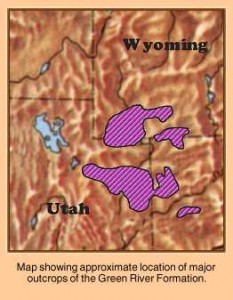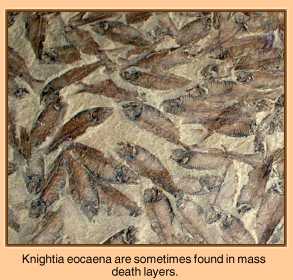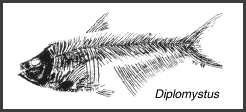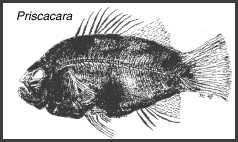Historical Background
In 1856 Dr. John Evans collected the first fossil fish known to science from the Green River Formation. The Knightia eocaena was described by Dr. Joseph Leidy in Philadelphia. Although fossils had been reported from the area, this was the first described. And so begins the story of one of the greatest fossil sites known to science.
Soon after, geologists, railroad workers, and others started reporting fossil sites in surrounding areas. Most of the fish collected were sent to Edward Drinker Cope, who did the majority of the work on the fish fauna of what became known as the Green River Formation. Cope travelled west and did some collecting of his own, and in 1871, published a major work on the fishes.
The Green River Formation outcrops in the states of Wyoming, Utah and Colorado and showcases the remains of a large lake system. Scientists have determined that the system was made up of three lakes that varied in size and depth through time. The system existed for just over twenty million years, forming about sixty million years ago and disappearing around the end of the Eocene.
The formation preserves the remains of a subtropical environment. The extremely fine-grained sediments produced beautiful fossils that grace the collections of museums around the world. They also grace the collections of many amateurs, the fish being for sale in almost every rock shop in the country, many museum shops and every souvenir shop in the Midwest. The formation has produced over a million specimens with over one half million in the last thirty years alone.
The Lakes
Fossil Lake was the deepest of the three lakes in the system. It had a small surface area and was short-lived. Fossil Lake produces the largest share of fish specimens of the three lakes.
Lake Gosiute produced a smaller variety of fossil fishes and a different state of preservation as well. It outcrops near the Fontenelle Reservoir and near the Farson Dam. The shales and fossils are not the typical Green River specimens most of us are familiar with.
Lake Uinta was the largest in surface area but was the shallowest. In existence for 17 million years, it was the longest-lived of the three lakes. Its sediments form one of the thickest lacustrine sediments known, almost 7000 feet in some places.
Two species are known with K. eocaena being the most common. A member of the herring family, they average five inches in length with a maximum size of ten inches. They have a deeply forked tail and a single dorsal fin in front of the mid-body line. Knightia fed on algae, ostracods and insects and they were the major food source for many of the larger fish from the lakes. They were schooling fish and are frequently found in mass mortality or “death” layers. Fossils have been found packed as densely as several hundred fish per square meter of slab rock.
Mioplosus
Cope described two species of this perch-like fish, however, present-day researchers doubt the existence of M. sauvagenus. With the only specimen found having been lost, no further study is possible. M . labracoides is a fairly common predator easily distinguished by the two dorsal fins, large fan-shaped tail and an anal fin equal and opposite its second dorsal fin. A voracious predator, Mioplosus is the fish most commonly found eating other fish, something for which the Green River fish fossils are famous.
Diplomystus
The upturned mouth of this herring type fish indicates that it was probably a surface feeder. They have a wide anal fin, single dorsal fin, and a deeply forked tail. The maximum size is listed at twenty-six inches, but they are more commonly three to six inches. D. dentatus is also known from the Cretaceous of South America. When Cope originally erected the genus, he listed four species, however, more recent research has pared it down to D. dentatus only. Another Knightia predator, “Diplos” have been found containing fossils of their last meals.
Priscacara
Priscacara has grinding-type teeth, indicating that it probably fed on snails and crustaceans. It is easily identified by its stout dorsal and anal fin spines, which, in my opinion, make it the most attractive of the Green River fossils. Two species, P. serrata and P. liops, are the most common. Several others are under review by current researchers. Priscacara are known only from the Eocene. They have a large oval body and range in size from one inch to fifteen inches with four to six most common. They were schooling fishes and are more commonly found in the eighteen-inch layer.
Phareodous
The largest of the common fishes is Phareodus. Two species, P. encaustus and P. testis, are known. They average fifteen inches, with a maximum of thirty inches. With the dorsal and anal fins located at the very back of the body, these fish cannot be confused with any other Green River species. They have large very sharp teeth and have been found with the remains of Mioplosus and Priscacara inside.
Courtesy: Tom Caggiano



 August 22nd, 2012
August 22nd, 2012  riffin
riffin 



 Posted in
Posted in  Tags:
Tags: 